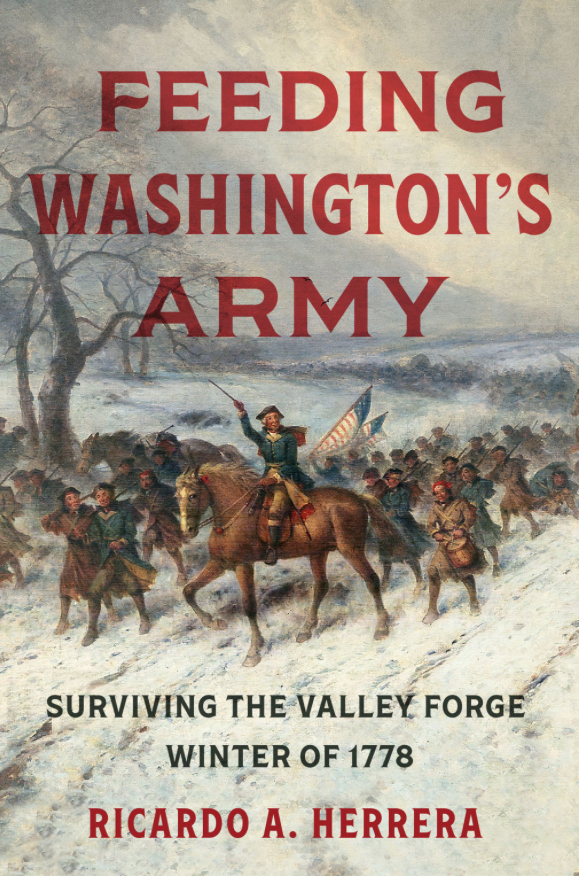
BOOK REVIEW: Feeding Washington’s Army: Surviving the Valley Forge Winter of 1778 byRicardo A. Herrera (Chapel Hill, NC: The University of North Carolina Press, 2022)
The myth of the Valley Forge winter encampment is that the Continental Army went through terrible conditions and heroically came out as a much more disciplined force in the end. Professor Ricardo A. Herrera’s new book, Feeding Washington’s Army: Surviving the Valley Forge Winter of 1778, is an intense and richly-detailed chronicle of the operation that staved off the army’s hunger. Herrera dispels the Valley Forge myth, showing that the Continental Army was not passively suffering during the winter. They were deeply involved with a series of operations that is now known as the Grand Forage. It demonstrated George Washington’s ability to wisely choose the best commanders to carry out his plans, while also showing Washington’s development as a military strategist and risk-taking planner. As the Americans were doing what they needed to do to feed their army, the British under Gen. Sir William Howe acted ineptly and lost the opportunity to end the rebellion.
How much food does an army need? What else besides food is important? Herrera does an excellent job in answering these questions. The success of a campaign is not based solely on either military strength or brilliant leadership. People often do not realize that an army on the march needs food and supplies to keep it going. Finding forage is only one problem. Once food and supplies are found and “extracted” (either voluntarily given or forcibly taken), they must be gotten to the army. According to Herrera’s figures, if the army had twenty thousand soldiers, thirty-three tons of food was necessary each day. Unfortunately for the Continental Army, the Congress was unable to get the needed resources from the loose confederation of states. How to pay for the supplies? It seemed to be an unanswerable question:
Payments were slow, Continental scrip was declining in value, Congress had no taxing authority to recall paper money and drive up its value, the states were loath to tax their citizens, and Americans were loath to pay taxes. Many Americans wanted the world, but few were willing to pay the price. [page 137]
While the British forces under Howe were settling in the city of Philadelphia, Washington was planning campaigns to forage the countryside. Geography was an important factor in the successes and losses of both armies. The British also needed forage, but often they plundered the area. They considered foraging to be a secondary priority. Washington was more sensitive to local farmers’ concerns and did his best to pay for supplies, but sometimes the army was forced to impress items:
The Continental Army held something of an existential middle ground in the War for Independence. It was an army of liberation in the eyes of many of its members, but also one of occupation and intimidation. Congress had charged it with defending American liberties and securing the nascent republic’s independence. To accomplish that task, it needed at times to deprive or deny other Americans, including Loyalists, Indians, and the enslaved, of their liberties. [p. 112]
Washington’s choices of commanders to oversee the Grand Forage showed his willingness to take great risks. He needed to trust these officers completely because the army’s survival was at stake. The best choice that he made was Nathanael Greene, whose value as a leader increased over time. Washington had full confidence in his abilities, and he was not disappointed. Anthony Wayne served as Greene’s deputy commander, helping to score important successes, such as several hundred head of cattle, dozens of horses, loads of forage, wagons, harnesses, and other supplies. Casimir Pulaski joined Wayne’s forces, although he did not prove his mettle. Capt. Henry Lee oversaw foraging in the Chesapeake region, where he fought the British light dragoons, trying to strip them of their supplies. Other commanders of the Grand Forage included William Smallwood, Peter Colt, and Col. Ephraim Blaine.
The Grand Forage was done as an act of desperation, says Herrera, but that desperation was necessary to ensure the Continental Army’s survival. Washington came into his own as a steady military and political strategist. He was able to keep the army going despite the harsh conditions, weak Congress, worthless money, mutinies, disaffected farmers, and British interference. Sir William Howe did not take full advantage of the Continental Army’s situation, and so the army survived to continue fighting. The Forage not only proved Washington’s abilities as a leader. Nathanael Greene’s talents and importance were recognized, and it showed the importance of Wayne and Lee. Valley Forge remained an active post through the winter of 1778 because of the Grand Forage.
Feeding Washington’s Army is an intense read, and Herrera does not miss any details in his work. He includes several portraits of the important players in the Grand Forage, along with maps and tables. A more careful editing job would have added to the book, but it did not obscure Herrera’s direct and easy narrative in any way. This is an important work about a consequential but little-known episode during the American Revolution. It is highly recommended.
PURCHASE THIS BOOK FROM AMAZON IN HARDCOVER OR KINDLE.
(As an Amazon Associate, JAR earns from qualifying purchases. This helps toward providing our content free of charge.)
Did you miss our previous article...
https://lessonsbeyondthestory.com/world-wars/was-constantinople-besieged-in-67478






